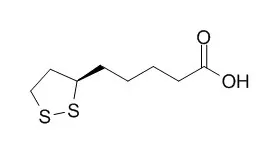| Kinase Assay: |
| Biochim Biophys Acta. 2009 Oct;1790(10):1149-60. | | Alpha-lipoic acid as a dietary supplement: molecular mechanisms and therapeutic potential.[Pubmed: 19664690 ] | Alpha-Lipoic acid (LA) has become a common ingredient in multivitamin formulas, anti-aging supplements, and even pet food. It is well-defined as a therapy for preventing diabetic polyneuropathies, and scavenges free radicals, chelates metals, and restores intracellular glutathione levels which otherwise decline with age. How do the biochemical properties of LA relate to its biological effects?
METHODS AND RESULTS:
Herein, we review the molecular mechanisms of LA discovered using cell and animal models, and the effects of LA on human subjects. Though LA has long been touted as an antioxidant, it has also been shown to improve glucose and ascorbate handling, increase eNOS activity, activate Phase II detoxification via the transcription factor Nrf2, and lower expression of MMP-9 and VCAM-1 through repression of NF-kappa B. LA and its reduced form, dihydroLipoic acid, may use their chemical properties as a redox couple to alter protein conformations by forming mixed disulfides. Beneficial effects are achieved with low micromolar levels of LA, suggesting that some of its therapeutic potential extends beyond the strict definition of an antioxidant.
CONCLUSIONS:
Current trials are investigating whether these beneficial properties of LA make it an appropriate treatment not just for diabetes, but also for the prevention of vascular disease, hypertension, and inflammation. | | Int Immunopharmacol. 2008 Feb;8(2):362-70. | | Alpha-lipoic acid inhibits TNF-alpha induced NF-kappa B activation through blocking of MEKK1-MKK4-IKK signaling cascades.[Pubmed: 18182252] | The therapeutic effects of alpha-Lipoic acid (alpha-LA) via NF-kappa B down regulation were demonstrated on joint inflammation and erosion in an animal model.
METHODS AND RESULTS:
In this study, we investigated how alpha-LA inhibits the pathway of NF-kappa B activation by TNF-alpha via the mitogen-activated protein kinase (MAPK) pathway in rheumatoid arthritis (RA) fibroblast-like synovial cells (FLS). FLS were stimulated with TNF-alpha following pre-treatment with or without alpha-LA. Electrophoretic mobility shift assays (EMSA) revealed that TNF-alpha activates NF-kappa B in FLS. This was inhibited by alpha-LA at concentrations of 1 mM. TNF-alpha induced IKK mediated phosphorylation of GST-I kappa B and pre-treatment with alpha-LA inhibited this pathway. FLS constitutively express MEKK1, MEKK2, MEKK3, and TAK1 and that their levels are unaffected by TNF-alpha or alpha-LA. Immunoprecipitation using anti-MEKK1 antibody phosphorylated GST-I kappa B and pre-treating the cells with alpha-LA could abolish the reaction. FLS were immunoprecipitated using an antibody to MEKK1, and MKK4 was coprecipitated with MEKK1. In addition, immune complexes precipitated with anti-MKK4 antibody phosphorylated GST-I kappa B, and pre-treatment with alpha-LA inhibited the phosphorylation. Immunoprecipitation assay showed that MEKK1, MKK4, IKK-alpha, IKK-beta, I kappa B, and NF-kappa B comprised immunocomplex.
CONCLUSIONS:
It can be concluded that TNF-alpha activates NF-kappa B in FLS through MEKK1-MKK4-IKK signaling complex, and alpha-LA inhibits this signaling at the level of or upstream of IKK-alpha and IKK-beta. |
|






 Cell. 2018 Jan 11;172(1-2):249-261.e12. doi: 10.1016/j.cell.2017.12.019.IF=36.216(2019)
Cell. 2018 Jan 11;172(1-2):249-261.e12. doi: 10.1016/j.cell.2017.12.019.IF=36.216(2019) Cell Metab. 2020 Mar 3;31(3):534-548.e5. doi: 10.1016/j.cmet.2020.01.002.IF=22.415(2019)
Cell Metab. 2020 Mar 3;31(3):534-548.e5. doi: 10.1016/j.cmet.2020.01.002.IF=22.415(2019) Mol Cell. 2017 Nov 16;68(4):673-685.e6. doi: 10.1016/j.molcel.2017.10.022.IF=14.548(2019)
Mol Cell. 2017 Nov 16;68(4):673-685.e6. doi: 10.1016/j.molcel.2017.10.022.IF=14.548(2019)